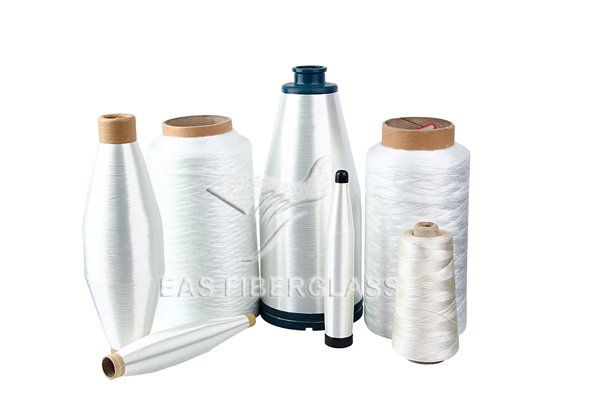Glass cloth is divided into two types: alkali-free and medium-alkali. Most of foreign countries are E-GLASS alkali-free glass cloth. Glass cloth is mainly used to produce various electrical insulating laminates, printed circuit boards, various vehicle bodies, storage tanks, boats, molds, etc. Medium-alkali glass cloth is mainly used in the production of plastic-coated packaging cloth, as well as in corrosion-resistant occasions. The characteristics of the fabric are determined by fiber properties, warp and weft density, yarn structure and weave. The warp and weft density is determined by the yarn structure and texture. The density of warp and weft plus the yarn structure determines the physical properties of the fabric, such as weight, thickness and breaking strength. There are five basic weaves: plain weave plan (similar to checkered cloth), twill weave (usually +-45 degrees), satin weave statin (similar to unidirectional cloth), rib leno (the main weave of glass fiber mesh) and Mats (similar to Oxford cloth).
Fiberglass belts are divided into woven-edged tapes (light-edged tapes) and unwoven-edged tapes (frayed tapes). The main weaving method is plain weave. Alkali-free glass fiber tape is often used to manufacture high-strength, good dielectric properties of electrical equipment parts.
Glass fiber unidirectional fabric, unidirectional fabric. The unidirectional fabric is a four-warp broken satin or long-axis satin fabric woven from thick warp yarns and fine weft yarns. It is characterized by high strength in the main direction of warp yarns at 0 degrees. . There are also glass fiber single weft fabrics. There are two weaves, warp knitting and weaving. They are characterized by thick weft yarns, fine warp yarns, and glass fiber yarns that are fed in the weft direction and have high strength in the 90-degree weft direction.
Glass fiber three-dimensional fabric three-dimensional fabric is relatively flat fabric, and its structural characteristics have developed from one-dimensional and two-dimensional to three-dimensional, so that the composite material with this reinforcement has good integrity and profiling, which greatly improves the composite material. The shear strength between layers and the resistance to damage tolerance. It was developed with the special needs of the aerospace, aviation, weapons, shipbuilding and other sectors, and its application has now been extended to the automotive, sports equipment, medical equipment and other sectors. There are five main categories: woven three-dimensional fabrics, knitted three-dimensional fabrics, orthogonal and non-orthogonal non-woven three-dimensional fabrics, three-dimensional woven fabrics and other forms of three-dimensional fabrics. The shapes of three-dimensional fabrics include block, column, tube, hollow truncated cone, and variable thickness special-shaped cross-section.
Glass fiber slot core fabric The slot core fabric is a fabric composed of two parallel fabrics connected by vertical vertical strips. Its cross-sectional shape can be triangle, rectangle, and honeycomb structure.
Glass fiber stitch-woven fabric is also called knitted felt or woven felt, which is different from ordinary fabrics and felt in the usual sense. The most typical stitch-knitted fabric is a layer of warp yarn and a layer of weft yarn overlapped together, and the warp yarn and weft yarn are knitted together to form a fabric through stitching. The advantages of stitched braid are as follows: ①It can increase the ultimate tensile strength, delamination strength and flexural strength of FRP laminated products; ②Reduce the weight of FRP products; ③Flat surface makes the surface of FRP smooth; ④Simplify Hand lay-up operation improves labor productivity. This kind of reinforced material can replace continuous raw silk felt in pultrusion FRP and RTM, and can also replace checkered cloth in the production of centrifugal FRP.
 EAS Fiberglass Co.,Ltd is a professional fiberglass products supplier and provide comprehensive and effective material industrial solution covering market high performance FRP, high effective temperature insulation, high convenient construction. Nowadays, EAS owns various products lines of fiberglass yarn forming, woven fabrics, fabrics coating/lamination, FRP etc. The complete products lines enable EAS highly mastering the quality control and products market competitive. Taking this advantage involve us in large many projects and enhence the brand promotion. Certified ISO9001-2008 equips EAS stuff and management more professional operation. Certification of test report for producs are made by third party laboratory SGS, TUV, DNV, etc.
EAS Fiberglass Co.,Ltd is a professional fiberglass products supplier and provide comprehensive and effective material industrial solution covering market high performance FRP, high effective temperature insulation, high convenient construction. Nowadays, EAS owns various products lines of fiberglass yarn forming, woven fabrics, fabrics coating/lamination, FRP etc. The complete products lines enable EAS highly mastering the quality control and products market competitive. Taking this advantage involve us in large many projects and enhence the brand promotion. Certified ISO9001-2008 equips EAS stuff and management more professional operation. Certification of test report for producs are made by third party laboratory SGS, TUV, DNV, etc.
